Saint-Étienne are one of the most historic clubs in French football. In the 1950s, ‘60s and ‘70s, they enjoyed one of the most impressive periods of any team in French football history, winning nine Ligue 1 titles (the 10th and final of which came in 1980/81), six Coupes de France, five Trophées des Champions and even reaching the European Cup (now UEFA Champions League) final in 1975/76 — losing that game at Hampden Park versus Bayern Munich.
Since then, mismanagement, poor decisions and various scandals have led to the one-time force to be reckoned with in European football freefalling; this leads us to 2021/22, when Les Verts, who still share the record for most Ligue 1 wins in history alongside PSG (10) were relegated from Ligue 1 for the first time since a scandal in 2000/01 saw them docked points and sent down to Ligue 2.
A team of Saint-Étienne’s stature should look to bounce straight back up following relegation. However, the start of the 2022/23 campaign has been more of the same misery from last season for fans of Les Verts, with new boss Laurent Batlles guiding his side to just 11 points from their first 13 games of the campaign — the joint-lowest points total of any side in France’s second-tier.
This is alarming, and ASSE will need to focus on climbing out of yet another relegation battle — this time in the second division — before even considering regaining their place among France’s elite in the top tier.
So, what’s going wrong this term? One obvious major problem is Saint-Étienne’s failure to keep goals out of their net. Les Verts have currently conceded the joint-most goals of any Ligue 2 side 13 games into the campaign, shipping 23 so far.
This tactical analysis and scout report aims to provide some insight into Saint-Étienne’s defensive deficiencies in 2022/23. We’ll provide an analysis of Batlles’ tactics and his team’s abilities to pinpoint some of the key weaknesses in Saint-Étienne’s defensive game that’s led to their dreadful defensive record this term.
Shapeshifting
Saint-Étienne have conceded the ninth-highest xGA (17.15) in Ligue 2 this term in addition to conceding the most actual goals in the league. While this is obviously much lower than their actual goals conceded, it’s still far from good enough for a team that wants to compete at the top end of the table.
They allow the opposition to create relatively easy goalscoring chances; Saint-Étienne have allowed their opponents to generate 0.144 xG per shot this season, which is the third-highest xGA per shot of any Ligue 2 side, which goes some way to explaining why they’ve conceded so many goals. If the average quality of chance their opponents enjoy is generally that high, they shouldn’t expect to keep that many clean sheets — and ASSE have kept three clean sheets so far this term.
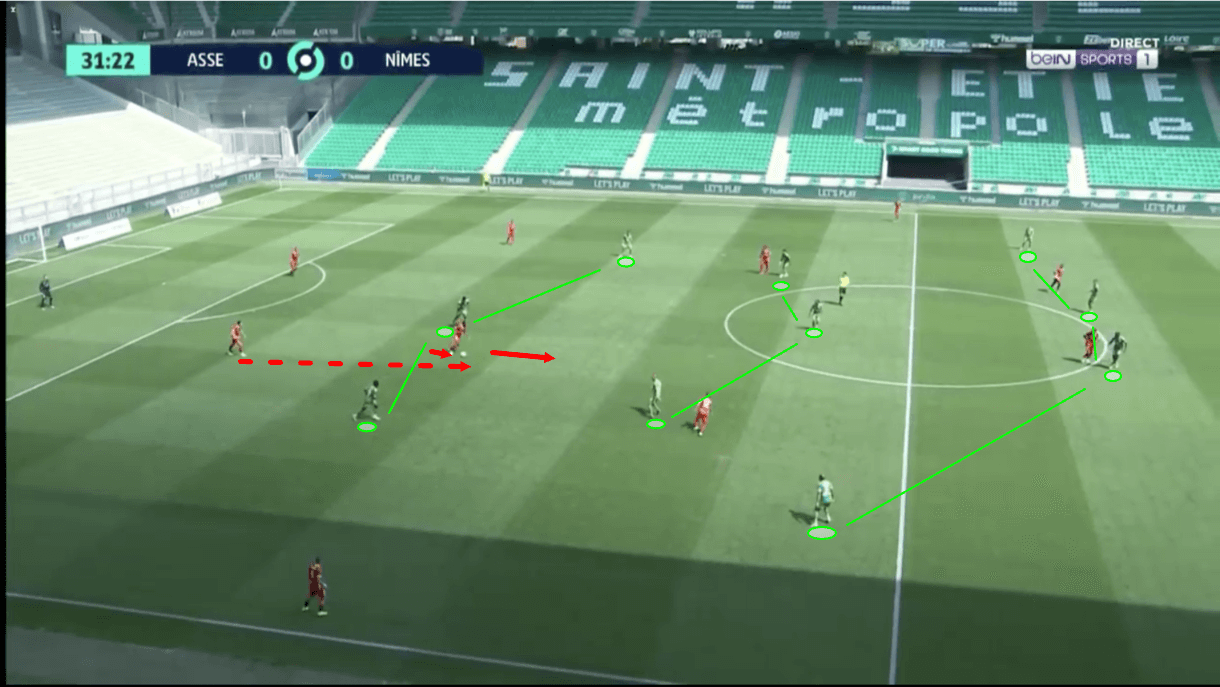
Batlles has chopped and changed shape regularly this term, failing to really settle on anything thus far. The main formations in which ASSE have set up this term have been the 3-4-1-2, 3-5-2, 3-4-3, 4-2-3-1 and 4-3-3. It was more common to see them utilising four-at-the-back systems at the beginning of the campaign before they switched to playing with three centre-backs more regularly. We see an example of ASSE in a 4-3-3 in Figure 1; this is taken from their early-season clash with Nîmes Olympique, who are also battling at the bottom of the second tier right now.
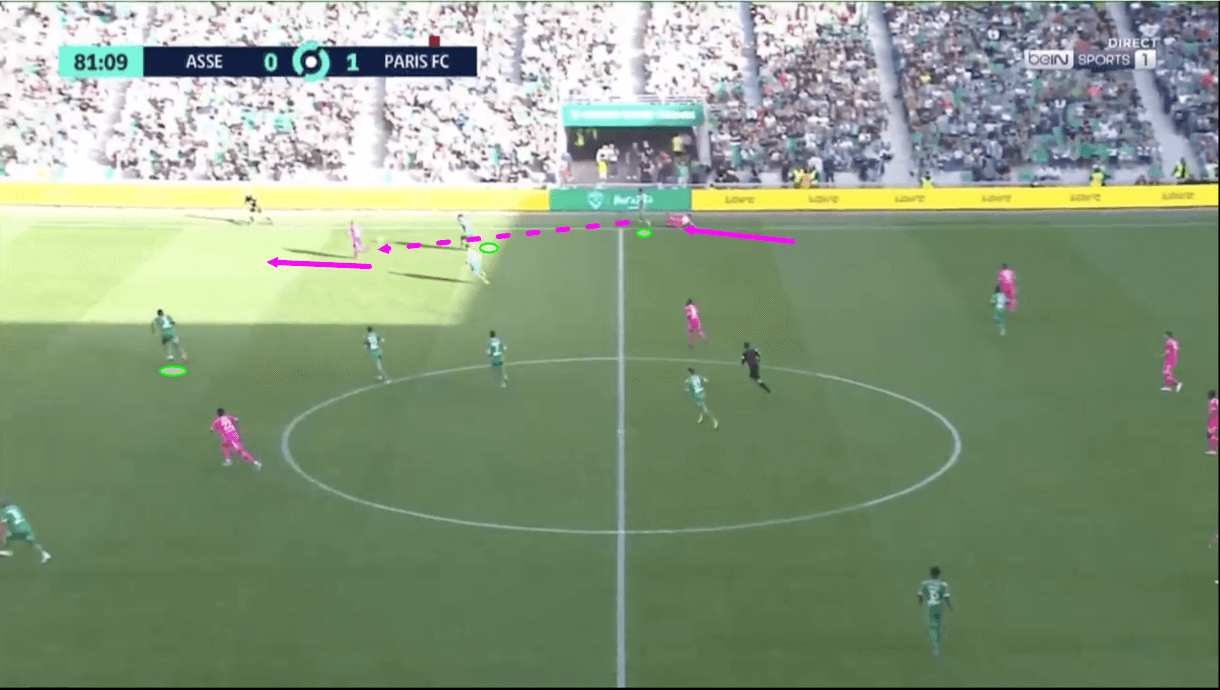
Combined with their general tendency to play with a fairly high line and try to press aggressively, Saint-Étienne’s four-at-the-back systems have typically had a common issue of allowing the opposition to exploit the space in behind the backline too easily, especially behind the full-backs. This has seen their centre-backs get dragged out into wide areas and into 1v1s that they’re not always entirely comfortable with. We see this in figures 2-3, taken from ASSE’s recent clash with Paris FC, in which they reverted to a four-at-the-back system.
Here, the opposition played the ball in behind ASSE’s left-back, allowing an attacker to exploit that space, get on the ball and drive forward with it.
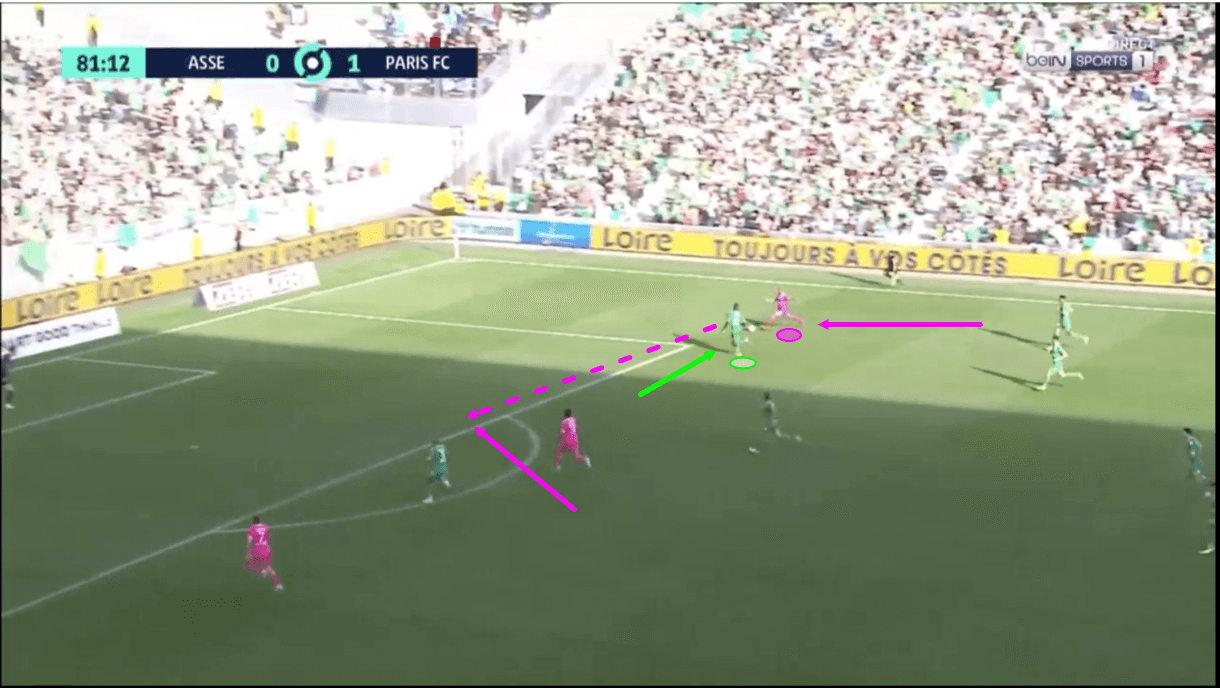
As the ball carrier drove forward, he dragged Saint-Étienne’s left centre-back out wide into a 1v1, this then created space centrally for another Paris FC attacker to exploit and get onto the end of a low cross — an example of how ASSE’s opponents have enjoyed so many goalscoring chances from high-value positions this season. This shows how Saint-Étienne’s high backline has been exposed a lot, especially when they utilise four in the backline. We’ll look more into the reasons why this problem has occurred so much this term later in this analysis.
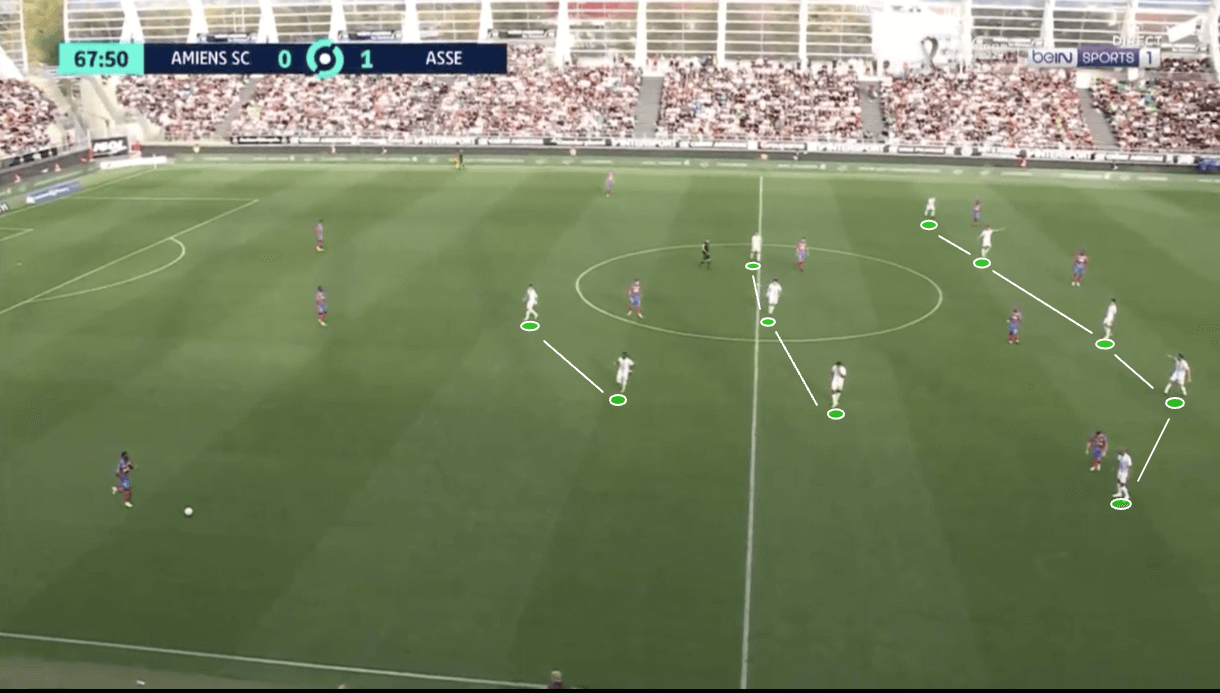
It’s been far more common to see Saint-Étienne playing with five-at-the-back without the ball in recent weeks, as we see in figure 4. This shape, in theory, provides extra padding in the backline, allowing for the wide centre-backs to get dragged out wide without as much space appearing centrally as appeared in figure 3. However, though it requires crisp and precise passing play, this shape can also be ripped apart and exposed at the back.
Poor in duels
Saint-Étienne have tried to deploy a high-pressing system in Ligue 2 this season. They want to win the ball high, force turnovers in delicate areas and dominate in transition. However, their players have not exactly excelled in duels this season.
While Saint-Étienne have got the second-lowest PPDA in Ligue 2 this term, displaying their aggressive tendencies, they’ve also got the fifth-lowest defensive duel success rate (59.6%), fourth-lowest tally of interceptions (34.7 per 90) and third-worst aerial duel success rate (41.9%).
So, while they will win the ball back high at times as a result of their intensity and aggression, it’s also common enough to see them get beaten in 1v1s and fail to win the ball after committing, thus leaving themselves vulnerable in deeper areas.
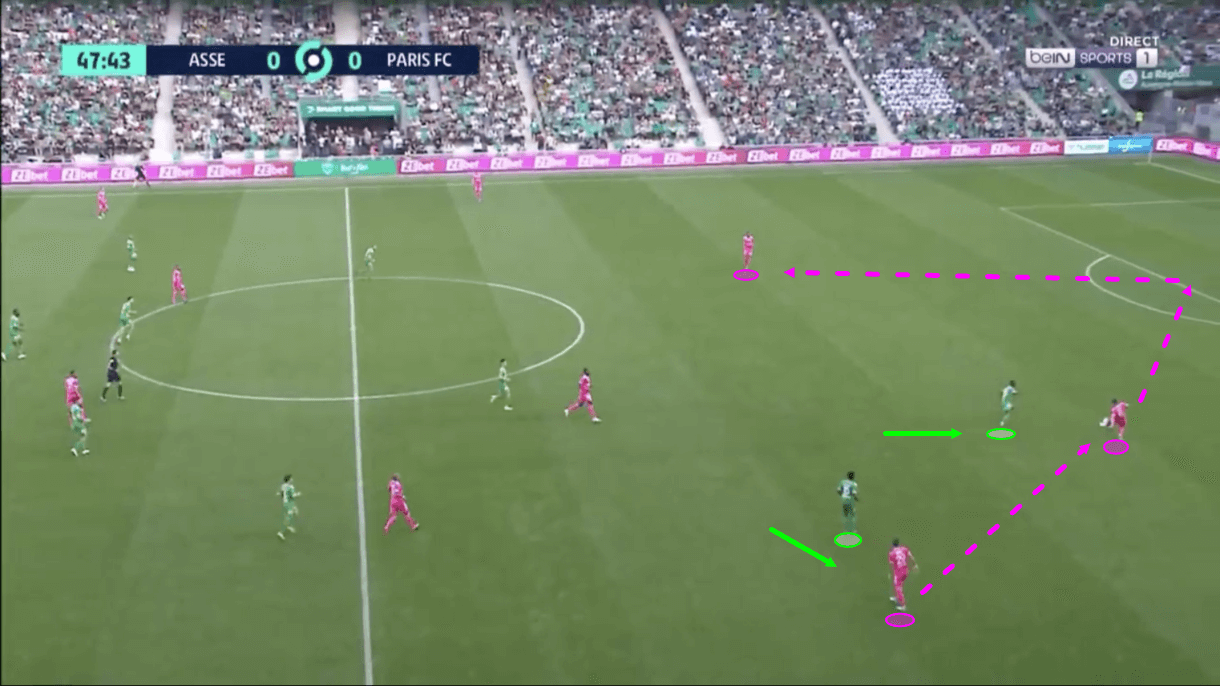
Firstly, it’s common to see ASSE’s forward duo commit to the press against the opposition’s backline. However, it’s also common to see the opposition outnumber their forward duo with their deepest players in possession, helping them to progress beyond Saint-Étienne’s first line of defence.
ASSE also deploy a very ball-oriented pressing scheme, meaning that when their opponents shift the ball across the pitch quickly, it can allow them to find players in plenty of space, like the right centre-back in figure 5, who’s got a lot of space between him and either the left-forward or the left central midfielder.
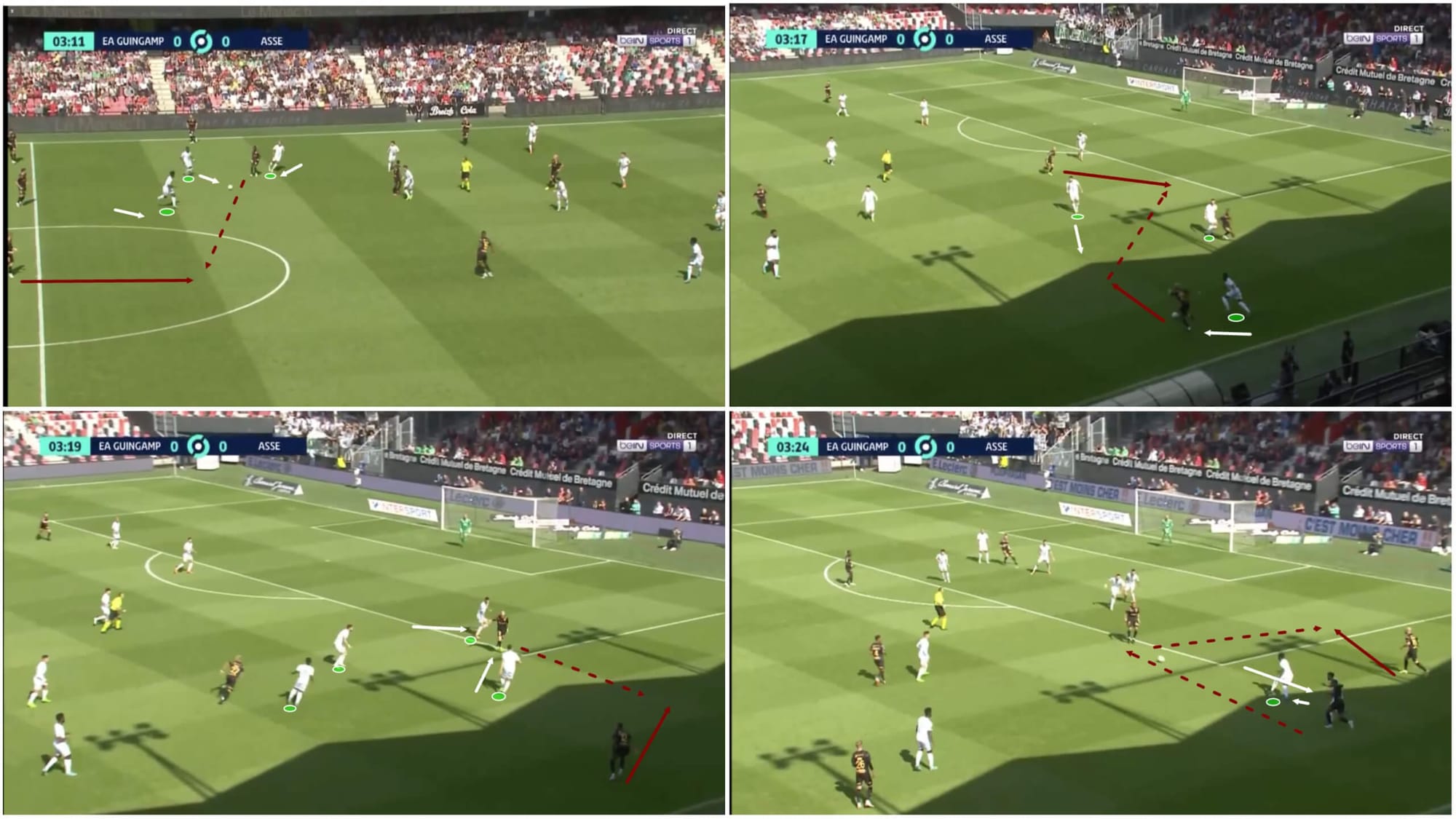
Saint-Étienne’s struggles to win duels, some of their players’ struggle to defend with the necessary amount of aggression and intensity to get tight to players and close them down and this ball-oriented pressing approach have been a dangerous combination of traits for Batlles’ side to be displaying.
We can see examples of how following the ball but ignoring space — not even that far from the ball carrier — allowed EA Guingamp to find a path through Saint-Étienne’s entire defensive shape in figure 6. They don’t track off-the-ball runners near the ball carrier well enough. If teams create triangles in small areas like we see in the bottom-right quartile of figure 6, Saint-Étienne struggle to cope with that and it’s common to see the opposition create and find a free man. Guingamp worked their way upfield through the opposition’s shape by doing this in figure 6.
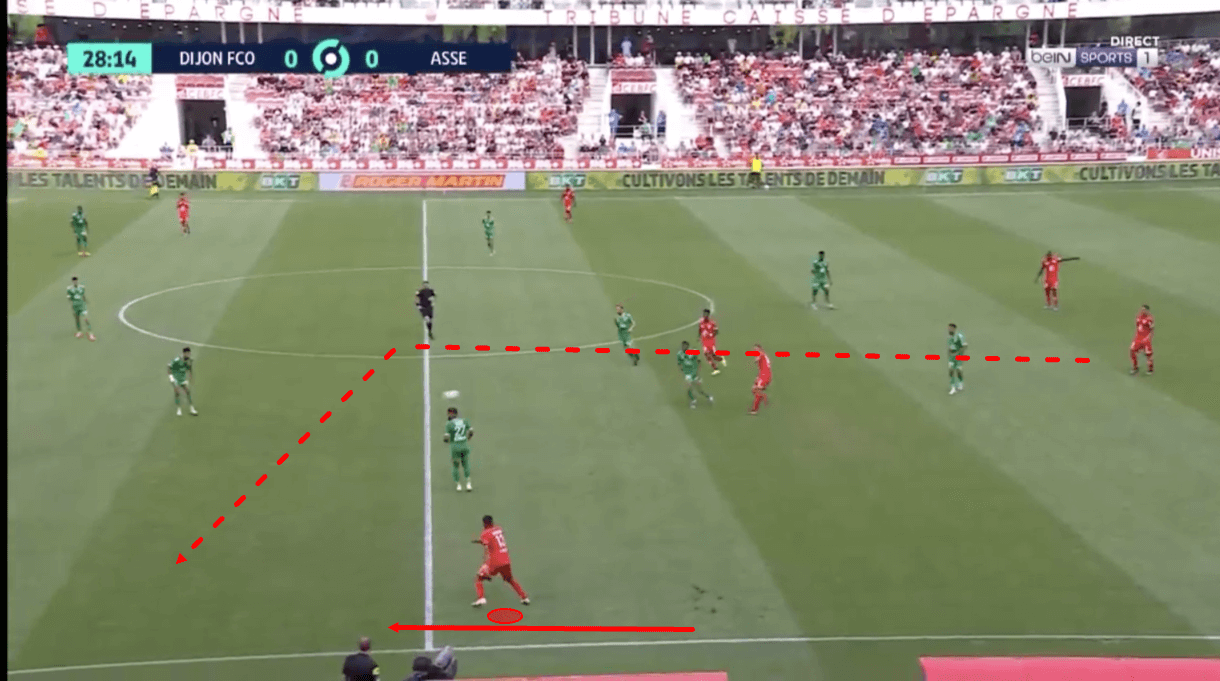
The ball-oriented pressing approach can often leave Saint-Étienne vulnerable on the wings, especially on the opposite wing via a big switch of play. We see an example of Saint-Étienne’s opponents Dijon exploiting some space out on the left wing via a lobbed pass over the right wing-back in figure 7.
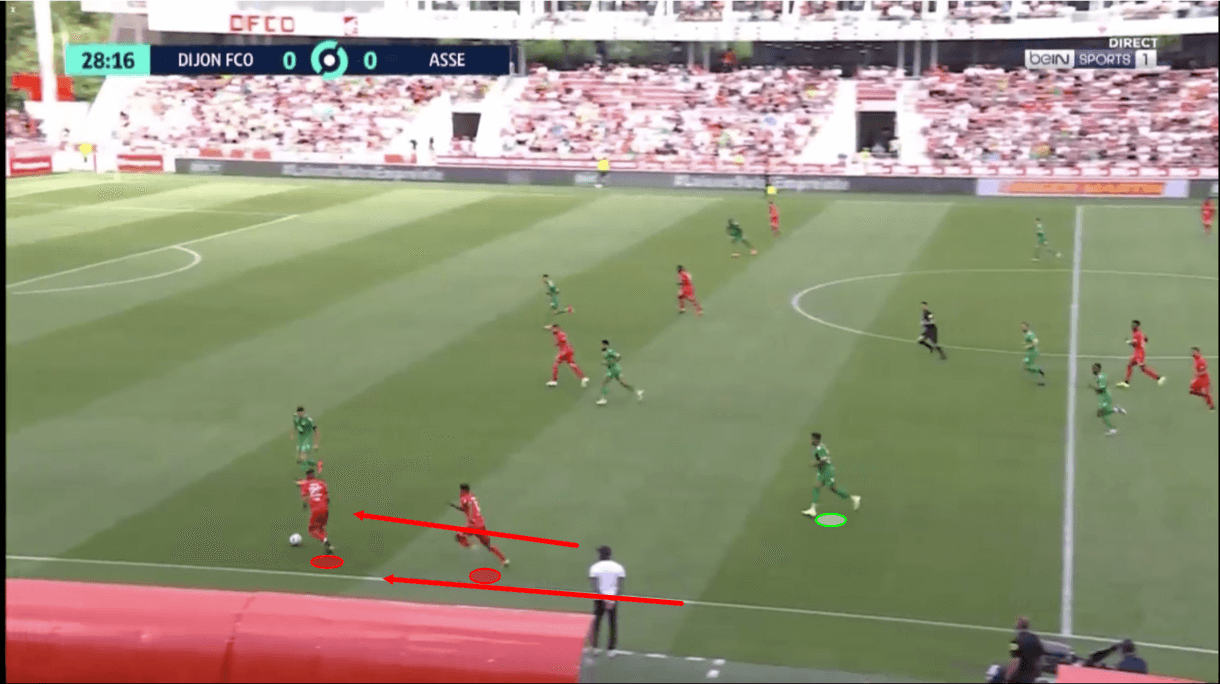
In figure 8, as this passage of play moves on, we see that receiver from the previous image has linked up with the winger on that side, playing them the ball before carrying on their run and getting up in support, offering an option on the overlap.
It’s too easy for Dijon to create a 2v1 overload versus Saint-Étienne’s right-back here. The ASSE player circled in figure 8 was level in terms of how deep his positioning was with the receiver when he initially got on the ball in figure 7. Granted, the ASSE man had to turn so he was at a disadvantage but he falls far behind and doesn’t make enough of an attempt to get back in support, rather jogs back while Dijon’s left-back sprints forward in support. This is a big difference between the two teams’ physical output and mentality in this specific moment that creates a big advantage for Dijon to break into the final third.
This wasn’t a one-off either, which will be frustrating for Batlles and Saint-Étienne as a team, who undoubtedly will want to do better in such situations and help their teammates out more to avoid getting isolated so easily in 1v1s and 2v1s — which has happened too often this term, allowing the opposition to progress into Saint-Étienne’s box and create high-value goalscoring opportunities. This, like ASSE’s pressing scheme, can be and has been exploited in transitions as much as it’s been exploited in settled possession phases.
This goes for discipline as well, with Saint-Étienne currently the proud holders of the record for most yellow cards and most red cards in France’s second-tier for 2022/23. Again, this is a failure of the players to succeed in their duels, often arriving late, getting stuck in and committing a very avoidable foul. Perhaps the personnel and system don’t suit one another right now.
So, blame really may lie all around the team, from the coach to the players, when it comes to Saint-Étienne’s poor performance in defensive duels this term.
Deep turnovers
The final section of this scout report will focus on Saint-Étienne’s tendency to concede turnovers in dangerous parts of the pitch, which can leave their backline and/or goalkeeper very vulnerable in transition.
Saint-Étienne like to try and play through the thirds to create their chances, as opposed to regularly playing it direct from kick-off. They don’t play many long balls — just 36.29 per 90 this season, the lowest total for long balls in Ligue 2 this season.
Playing like this comes with risk and unfortunately for Saint-Étienne, they’ve experienced that risk first hand this term, as they’ve crashed and burned when playing out from the back at times, which is another area of improvement for Les Verts if they want to reduce their xGA per shot as the season progresses.
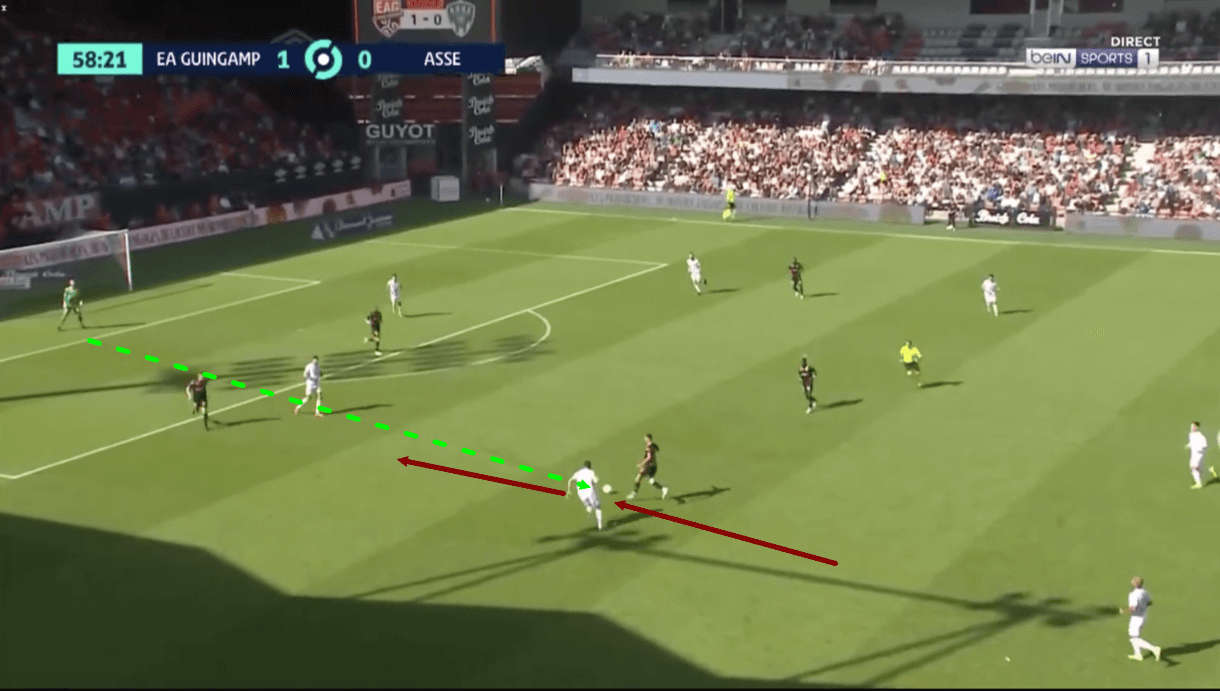
Figure 9 shows one example of Saint-Étienne’s attempts to play through the thirds from the back not quite going to play, as the goalkeeper’s pass towards his midfield teammate was misplaced, allowing an opposition midfielder to step up, cut the pass out and drive at ASSE’s right centre-back. The midfielder quickly created a 2v1 versus this player before setting up his side’s left-forward in a 1v1 with the right centre-back. This player progressed beyond the Saint-Étienne man and set up a high-value goalscoring opportunity for himself inside the penalty area.
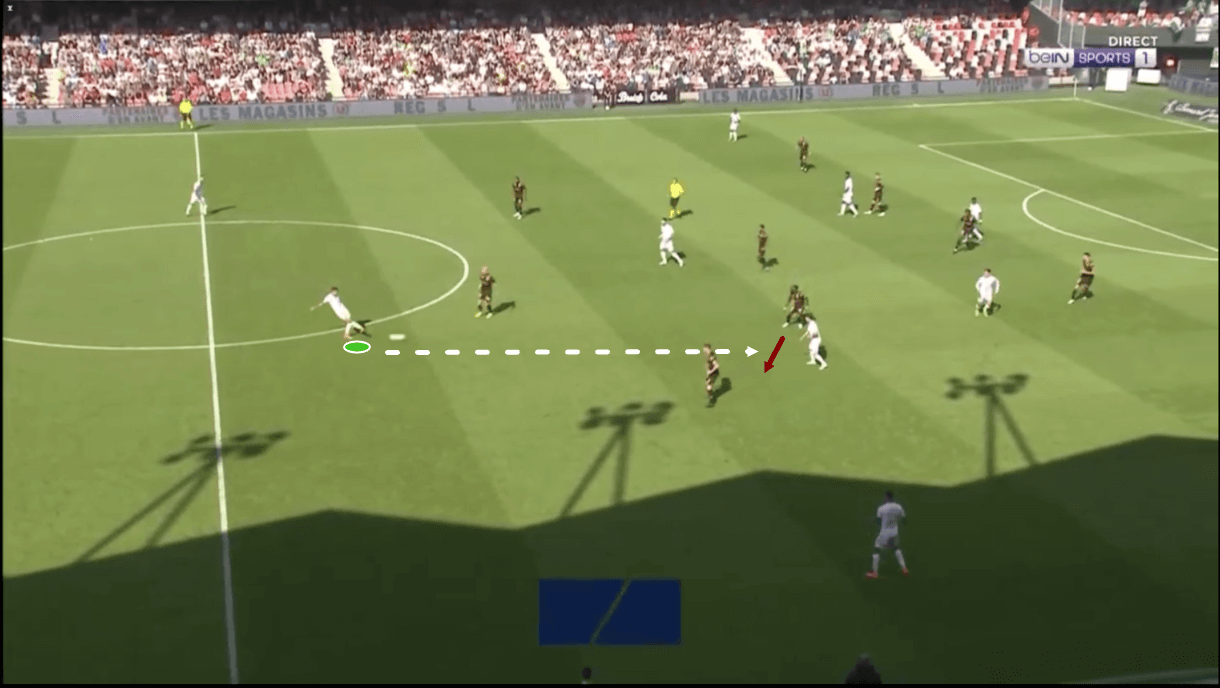
Another slightly misplaced, slightly underhit pass allowed the opposition to regain possession in a dangerous area in figure 10. This time, we see Saint-Étienne in the progression phase rather than the build-up but the danger is just as high for losing the ball here, if not higher, as the opposition have so much space behind ASSE’s backline to exploit, while we see just two Saint-Étienne players in the backline, leaving them very vulnerable — essentially, sitting ducks.
Conclusion
To conclude this tactical analysis and scout report, it’s clear that the coach and players all need to take another look at what they’ve been doing so far this season and improve in some key areas — as discussed in this piece — in order to improve the team’s standing in Ligue 2. Failure to do so could well leave Saint-Étienne in yet another relegation battle for the duration of the campaign, as they can’t afford to keep conceding the kinds of chances they have been this term.





Comments